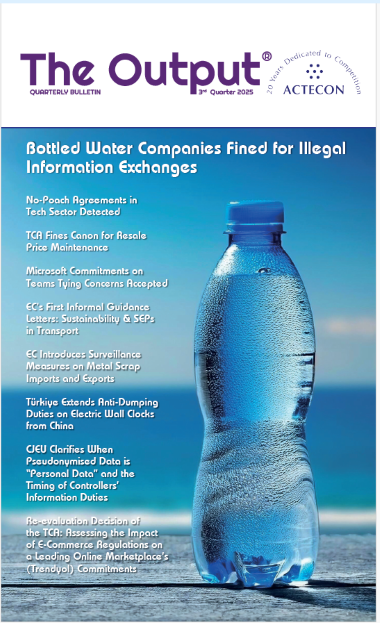The TCA to Promote Competition in Digital Markets: An Analysis in light of G7’s Compendium
| Competition Law

The TCA to Promote Competition in Digital Markets: An Analysis in Light of G7’s Compendium
Article by Mustafa Ayna, Burak Buğrahan Sezer and Arda Deniz Diler
Since the use of digital platforms within daily life and the context of work is on the rise, the competition authorities are focusing more and more on the competitive issues and market failures in digital markets. With the rapid growth of digital markets, each and every day competition regulations confront with grey areas where national competition authorities are faced with sui generis issues.
As a result of a joint attempt of the competition authorities of the G7[1] countries and four guest countries,[2] a compendium on competition in digital markets ("Compendium") was published on 29 November 2021.[3] The main aim of the Compendium is to present different approaches adopted by different competition authorities to promote competition in digital markets. Accordingly, the Compendium includes sections on how to promote competition in digital markets, identfying common problems encountered in these markets and opportunities for mutually productive work.
The Compendium includes evaluations under three main headings: (i) Key Challenges, (ii) Key Findings, and (iii) Conclusions and Next Steps. This article provides an overview of the Compendium. In addition, a recap of the works and studies of the Turkish Competition Authority (“TCA”) regarding competition in digital markets is included in the article in order to provide a comperative analysis.
Key Challenges
The section on key challenges emphasizes that digital markets offer significant benefits to consumers, businesses, and society. In this context, these markets allow businesses to grow quickly, help consumers to access new products and interact with others, and spur innovation and economic growth. However, concerns exist about lack of competition, particularly given the characteristics of digital markets, and about the possibility that a few large undertakings can impose significant market power on their competitors and consumers.
Among these two elements, the first one to be examined is the concept of market power. Many digital markets have common features, and these features contribute positively to the efforts of undertakings in gaining a strong position in the market. In terms of common features, three features are emphasized particularly: network effects, existence of multi-sided markets, and the role of data.
Network Effects
While network effects can have significant benefits for consumers and platform businesses, they can also have adverse effects on the competition by increasing market concentration and entry barriers to the market, and by helping the consolidation of existing market power. The authors argue that this can provide undertakings that enjoy great market power the ability and incentive to suppress competitors that are deemed likely to pose a threat in the future.
Multi-sided Markets
The Compendium states that in multi-sided businesses, economic factors on one side of the platform may be influenced by the conditions of competition on the other. Digital platforms, for example, may not charge a service fee to consumers in order to maximize profitability and rely on the income generated by advertisers. In this manner, digital platforms are able to subsidize the cost of services provided to the consumers with the revenue they earn from the other side of the market, from the advertisers. As mentioned in the following sections of this article, this situation can be considered to possess a beneficial efficiency for the consumer, even when it is regarded as a challenge. Aside from that, no positive or negative point is highlighted in the case of multi-sided businesses.
The Role of Data
The Compandium discusses how access to data has become a requirement to compete and offer innovation, and that when this requirement is evaluated alongside other market features such as network effects, the inability to access data emerges as a barrier to entry into core and complementary markets. These characteristics, taken together, may lead to long-term and entrenched market power, which can produce anti-competitive effects such as higher prices and fewer options for consumers, as well as restrictions on competitors’ access to the market.
The second issue examined under key challenges section is the challenges to the existing enforcement approaches. It is stated in the Compendium that a weaker competition in digital markets will cause some difficulties for competition policies and enforcement. In this context, the effects in the market may be different from the price effects occurring in traditional markets and may require new theories of harm. It is asserted that features such as the multi-sided nature of online platforms make it difficult for courts and authorities to evaluate digital platforms within the traditional frameworks. One of the fundamental examples of this issue is the difficulty in determining a market definition.
Furthermore,it was claimed that although competition authorities have intervened especially against the most powerful digital undertakings, these interventions have not restored competition sufficiently. In addition, digital undertakings operate in a global framework and are tightly bound to areas such as data protection and consumer protection as well as competition. It is recommended that regulators and policymakers in different jurisdictions work together in an interdisciplinary way.
Key Findings
In the discussion of Key Findings, crucial issues in digital markets are evaluated in four categories: (i) digital advertising, (ii) the role of algorithms, (iii) marketplaces and app stores, and (iv) mergers.
The Compendium presents the decisions and works of the contributing competition authorities on the related issues. When these decisions and works are explored, the decisions made by the French competition authority[4] and the European Commission[5] regarding Google stand out in terms of digital advertising.
The authorities commonly have found Google’s actions, such as preventing others from adverting or displaying its own adverts primarily, exclusionary for its competitors and have enforced fines and behavioral remedies.
At this point, it is worth mentioning that the TCA also acted in paralel in its Google Adwords Decision,[6] concluding that Google abused its dominance by increasingly placing text advertisements, with an uncertain advertisement quality, at the top of the general search results, thus, complicating the activities of the organic search results that do not yield advertising revenue in the content services market. Likewise, in its Google Shopping Decision,[7] the TCA stated that Google abused its dominance after having determined that the company had put its competitors who offered comparison shopping services in a disadvantaged position.
In later stages of the section, approaches and opinions of various competition authorities are shared and evaluated to provide a better understanding of the mechanics of algorithms and their effect on competition. The joint report of the German and French competition authorities,[8] as well as that of the UK Competition and Markets Authority (“CMA”),[9] stand out in terms of evaluating the role of algorithms. On the same subject, the decisions of the US Department of Justice's Antitrust Division[10] and the CMA[11] on Amazon also are highlighted.
Within the scope of the Compendium, self-preferencing, price parity clauses, and restrictive terms of business between sellers and platforms are reported to be common practices for marketplaces and app stores. In this regard, decisions of various competition authorities regarding Amazon and Apple come to the fore. In this context, the TCA's Google Android Decision[12] should also be worth mentioning. In the decision, it was found that Google had abused its dominance in the market of licensable mobile operating systems by placing provisions on the prioritization and exclusivity of its own products in its contracts signed with device manufacturers.
In terms of mergers, widespread and well-founded concerns exist about underenforcement regarding mergers in digital markets. It is also noted that competition authorities recently have become more active in challenging, blocking, and remedying proposed mergers in these markets. In this regard, the Compendium cites several examples of various competition authority decisions dealing with both vertical and horizontal mergers and acquisition in digital markets.
In addition to above, evaluations for the strengthening of competition authorities are also included under Key Findings. It is remarked, in this regard, that the competition authorities have taken steps to strengthen institutional capacities. The significance of forming internal working groups and collaborating with external experts in the context of capacity building is emphasized. Furthermore, it is suggested that institutional knowledge is expanded, as digital markets are rapidly evolving and problems arise from time to time due to a lack of case law. However, as stated in the Compendium, the knowledge of competition authorities in this field has grown as a result of the sector reports and decisions produced in recent years. In this context, it can be deduced that the TCA follows a parallel approach as well; since, as it is known, the TCA has begun to employ experts with engineering backgrounds to assess digital market cases more accurately, which has improved its analyses of the digital markets.
Reforms to existing powers and approaches are another issue examined within the scope of Key Findings. Contributors to the Compendium state that despite the above-mentioned recent activities of competition authorities, additional mechanisms, powers, and safeguards specific to digital markets are required. The importance of modernizing and strengthening existing approaches is emphasized in this context. In parallel, with the amendment in 2020, the TCA’s power to conduct on-site inspections has been amended in a way that includes accessing digital data of the undertakings irrespectible of where they are stored.
In this context, emphasis is placed on the significance of new regulatory regimes and legislative efforts carried out by various jurisdictions, such as the European Commission's Digital Markets Act. Many competition authorities have stated that they intend to change procedures in order to act faster and thus be in a position to prevent damages, with practices such as interim measures, as well as to gain easier access to information. Furthermore, it is stated that jurisdictions that have not yet proposed similar reforms, face similar problems and can benefit from the experience gained from reforms that have been implemented already. As known, the TCA also has taken steps in such direction. The TCA initiated a sector inquiry concerning e-marketplace platforms on 11 June 2020,[13] publishing its preliminary report on 07 May 2021.[14] On 06 March 2021, another sector inquiry was initiated regarding the digital advertising market, where market failures and the possible legislative steps to be taken will be evaluated.[15]
Moreover, the Compendium argues that new approaches to merger control are required as mergers and acquisitions in digital markets are particularly unique in terms of thresholds. While such transactions may pose potential competitive risks due to the market features indigenous to digital markets, the turnover of one of the parties in such mergers and acquisitions may be low (or there may be no turnover) and fall outside the jurisdiction of the competition authorities. In this context, the Compendium includes works on the ability of various competition authorities to scrutinize mergers and acquisitions in the digital market without being hampered by thresholds.
Finally, the value of regulatory cooperation is assessed within the context of the Key Findings. It is pointed out that consumer data, in particular, is an important component of digital platforms, and that competition authorities should collaborate with data protection and consumer enforcement authorities in their evaluations of consumer data collection. Furthermore, according to the Compandium, digital markets are "borderless markets," and thus competition authorities should prioritize both international and domestic cooperation. The goal should be to learn about different approaches to similar problems and to benefit from this knowledge. In this area, the TCA has formed “The Balkan Initiative Platform,” which reflects the common will of nine Balkan countries for cooperation with respect to competition. The first workshop of the platform, “Recent Trends in Competition Law Enforcement in the Balkans,” was held on 09 November 2021.[16] One of the main topics at the workshop was the abuse of dominant position cases in digital markets.
Conclusions and Next Steps
In the section “Conclusions and Next Steps”, the Compendium states that many similarities exist between the problems faced by competition authorities in digital markets and the approaches taken by the same authorities to these problems. Increasing institutional capability and capacity, as well as carrying out interdisciplinary and inter-jurisdictional works, are examples of steps taken by authorities to improve their effectiveness. Finally, the submissions of the contributing authorities are included in the Compendium, and in this context, the relevant authorities presented their works and plans to be implemented in digital markets.
Are Things Moving Too Fast between Digital Markets and Competition Authorities?
As per the evaluations contained within the scope of the Compendium, there is a general acceptance that some new competitive concerns have arisen as a result of the characteristics of digital markets and that these concerns necessitate intervention. The same perspective also has been adopted by the TCA. However, different perspectives on the appropriateness and timing of these interventions can also be argued.
In this context, aside from the concerns it raises, as is firstly mentioned by the Compendium, the benefits brought by the advancement of digital markets to consumers and society overall are too significant to be overlooked. The benefits of network effects to consumers and competition, for example, as well as the free services provided to consumers on multi-sided platforms, are highlighted in the Compendium in this respect. Planned regulations should be discussed and analysed in order to balance the anticompetitive and procompetitive effects. New regulations, theories of harm and thresholds in mergers and acquisitions should be envisaged in a way that is sufficient in the sense of deterrence and protection of competition while without hindering the development of digital markets and innovation. In short, based on concrete information, further analysis can be performed to determine whether planned interventions are required.
Furthermore, the timing for implementing these policies, if they are to be implemented at all, is an important issue. Since digital markets mainly recently have come under the scrutiny of competition authorities, it would be beneficial to gain more market experience before intervening in the market with strict regulations. Being hasty can also mean penalizing success and pioneers, which, of course, reduces the incentive for competition, especially given that gatekeepers are the ones who create these gates while also being perceived as dangerous in terms of competition.
In conclusion, digital markets differ from traditional markets with their unique features. For this reason, it is argued that the interventions to competition problems seen in digital markets with traditional tools of competition law will be insufficient. However, with the impact of these unique features, digitalization also can offer sharp and rapid benefits compared to traditional markets. Therefore, although there is no doubt that these markets should be followed closely, it can be said that rushing to intervene in them will not necessarily be beneficial.
[1] The G7 consists of Canada, France, Germany, Italy, Japan, the United Kingdom, and the United States and the representation of the European Union.
[2] The UK invited Australia, India, South Korea, and South Africa to the G7 summit.
[3] See the press releaase and the Compendium at:
[4] the Autorité de la concurrence’s Decision dated 07.06.2021 and numbered 21-D-11.
[5] European Commission’s Decision dated 20.03.2019 and numbered 40111.
[6] The TCA Decision dated 12.11.2020 and numbered 20-49/675-295.
[7] The TCA Decision dated 13.02.2020 and numbered 20-10/119-69.
[8] See the joint report at:
[9] See the CMA’s report at:
[10] See the release by the US Department of Justice at:
[11] The CMA’s Decision dated 12.08.2016 and numbered 50223.
[12] The TCA’s Decision dated 19.09.2018 and numbered 18-33/555-273.
[13] See the press release at:
[14] See the report in Turkish at:
https://www.rekabet.gov.tr/Dosya/sektor-raporlari/e-pazaryeri-si-on-rapor-20210705115502897-pdf.
[15] See the press release by the TCA in Turkish at:
[16] See the press release by the TCA at:







